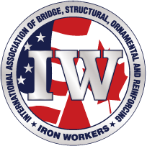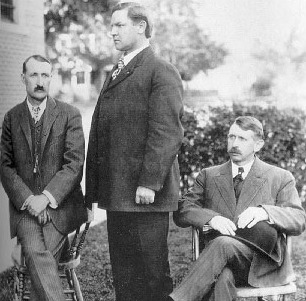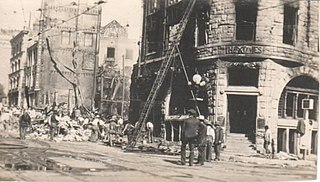Related Research Articles

The United Farm Workers of America, or more commonly just United Farm Workers (UFW), is a labor union for farmworkers in the United States. It originated from the merger of two workers' rights organizations, the Agricultural Workers Organizing Committee (AWOC) led by organizer Larry Itliong, and the National Farm Workers Association (NFWA) led by César Chávez and Dolores Huerta. They became allied and transformed from workers' rights organizations into a union as a result of a series of strikes in 1965, when the mostly Filipino farmworkers of the AWOC in Delano, California, initiated a grape strike, and the NFWA went on strike in support. As a result of the commonality in goals and methods, the NFWA and the AWOC formed the United Farm Workers Organizing Committee on August 22, 1966. This organization was accepted into the AFL–CIO in 1972 and changed its name to the United Farm Workers Union.

The International Ladies' Garment Workers' Union (ILGWU), whose members were employed in the women's clothing industry, was once one of the largest labor unions in the United States, one of the first US unions to have a primarily female membership, and a key player in the labor history of the 1920s and 1930s. The union, generally referred to as the "ILGWU" or the "ILG", merged with the Amalgamated Clothing and Textile Workers Union in the 1990s to form the Union of Needletrades, Industrial and Textile Employees (UNITE). UNITE merged with the Hotel Employees and Restaurant Employees Union (HERE) in 2004 to create a new union known as UNITE HERE. The two unions that formed UNITE in 1995 represented 250,000 workers between them, down from the ILGWU's peak membership of 450,000 in 1969.

The International Association of Bridge, Structural, Ornamental and Reinforcing Iron Workers is a union in the United States and Canada, which represents, trains and protects primarily construction workers, as well as shipbuilding and metal fabrication employees.

The Women's Trade Union League (WTUL) (1903–1950) was a U.S. organization of both working class and more well-off women to support the efforts of women to organize labor unions and to eliminate sweatshop conditions. The WTUL played an important role in supporting the massive strikes in the first two decades of the twentieth century that established the International Ladies' Garment Workers' Union and Amalgamated Clothing Workers of America and in campaigning for women's suffrage among men and women workers.

Charles H. Moyer was an American labor leader and president of the Western Federation of Miners (WFM) from 1902 to 1926. He led the union through the Colorado Labor Wars, was accused of murdering an ex-governor of the state of Idaho, and was shot in the back during a bitter copper mine strike. He also was a leading force in founding the Industrial Workers of the World, although he later denounced the organization.
The International Typographical Union (ITU) was a US trade union for the printing trade for newspapers and other media. It was founded on May 3, 1852, in the United States as the National Typographical Union, and changed its name to the International Typographical Union at its Albany, New York, convention in 1869 after it began organizing members in Canada. The ITU was one of the first unions to admit female members, admitting women members such as Augusta Lewis, Mary Moore and Eva Howard in 1869.

The Asian Pacific American Labor Alliance (APALA) is a nonprofit organization of Asian-Pacific American trade union members affiliated with the AFL–CIO. It was the "first and only national organization for Asian Pacific American union members".

The Los Angeles Times bombing was the purposeful dynamiting of the Los Angeles Times Building in Los Angeles, California, United States, on October 1, 1910, by a union member belonging to the International Association of Bridge and Structural Iron Workers (IW). The explosion started a fire which killed 21 occupants and injured 100 more. It was termed the "crime of the century" by the Los Angeles Times newspaper, which occupied the building.

Joseph Scott was a prominent British-born attorney and community leader in Los Angeles, California. His service to the community was so varied and important that he earned the nickname "Mr. Los Angeles."

Job Harriman was an ordained minister who later became an agnostic and a socialist. In 1900, he ran for vice president of the United States along with Eugene Debs on the ticket of the Socialist Party of America. He later twice ran for mayor of Los Angeles, drawing considerable attention and support. He also founded a socialist utopian community called Llano del Rio in California, later relocated to Louisiana.
Citizens' Alliances were state and local anti-trade union organizations prominent in the United States of America during the first decade of the 20th century. The Citizen's Alliances were closely related to employers' associations but allowed participation of a broad range of sympathetic citizens in addition to those employers apt to be affected by strikes. Originating in the American state of Ohio as the "Modern Order of Bees," the Citizens' Alliance movement spread westwards, playing a particularly important role in labor relations in the states of Colorado and California. Citizens' Alliance groups often worked in tandem with smaller but better financed employers' organizations interested in establishing or maintaining open shop labor conditions, including the Mine Owners' Associations (MOA) or the National Association of Manufacturers (NAM).
The California Agricultural Labor Relations Act (CALRA) is a landmark statute in United States labor law that was enacted by the state of California in 1975, establishing the right to collective bargaining for farmworkers in that state, a first in U.S. history.

The California agricultural strikes of 1933 were a series of strikes by mostly Mexican and Filipino agricultural workers throughout the San Joaquin Valley. More than 47,500 workers were involved in the wave of approximately 30 strikes from 1931-1941. Twenty-four of the strikes, involving 37,500 union members, were led by the Cannery and Agricultural Workers' Industrial Union (CAWIU). The strikes are grouped together because most of them were organized by the CAWIU. Strike actions began in August among cherry, grape, peach, pear, sugar beet, and tomato workers, and culminated in a number of strikes against cotton growers in the San Joaquin Valley in October. The cotton strikes involved the largest number of workers. Sources vary as to numbers involved in the cotton strikes, with some sources claiming 18,000 workers and others just 12,000 workers, 80% of whom were Mexican.

The 1992 Southern California drywall strike was a strike by Mexican and Mexican American drywall hangers, many of whom were undocumented, for fair wages and health insurance from contractors, who stole two billion dollars a years in income taxes, social security, and worker's compensation payments from the workers and collaborated with the local police to repress the organizers. Jesus Gomez, leader of the strike, received threats and had shots fired at his home, while key organizers were tailed by the police and even followed with helicopters. Eventually aligning with the United Brotherhood of Carpenters and Joiners, the strikers succeeded in getting union contracts that ensured fair wages and benefits. The strike left the residential construction industry in a different state. While the industry remained an open shop, contractors were forced to pay Mexican workers with wages and benefits closer to that of the white workers.
The Los Angeles Garment Workers strike of 1933 is considered to be one of the most influential strikes in Los Angeles after the passing of the New Deal. The strike is known for being one of the first strikes where Mexican immigrant workers played a prominent role. The garment workers strike occurred in the fall of 1933 in the downtown Garment District in Los Angeles, California. Leaders of the strike, including Rose Pesotta and other members of the International Ladies Garment Workers Union (ILGWU), organized the strike to be culturally orientated in order to include Mexican immigrant workers to fight for union recognition in the garment industry.

The International Longshore and Warehouse Union (ILWU) is a labor union which primarily represents dock workers on the West Coast of the United States, Hawaii, and in British Columbia, Canada. The union was established in 1937 after the 1934 West Coast Waterfront Strike, a three-month-long strike that culminated in a four-day general strike in San Francisco, California, and the Bay Area. It disaffiliated from the AFL–CIO on August 30, 2013.
The 1923 San Pedro maritime strike was, at the time, the biggest challenge to the dominance of the open shop culture of Los Angeles, California until the rise of the Congress of Industrial Organizations in the 1930s.

The Los Angeles streetcar strike of 1919 was the most violent revolt against the open-shop policies of the Pacific Electric Railway Company in Los Angeles. Labor organizers had fought for over a decade to increase wages, decrease work hours, and legalize unions for streetcar workers of the Los Angeles basin. After having been denied unionization rights and changes in work policies by the National War Labor Board, streetcar workers broke out in massive protest before being subdued by local armed police force.
The Neutral Thousands, initialized as TNT, was an organization created in 1937 to target union activities and was known as an anti-union organization. The organization rose along with a tide of similar organizations in the period of the late-19th century to the mid-twentieth century. Bessie Ochs, formerly a speaker for the Merchants and Manufacturers Association, was recruited by Byron C. Hanna, the leader of The Southern Californians, Incorporated, to lead the organization. In addition to the general activities of the organization, it also broadcast a radio program, referred to as the "California Caravan".
James B. McNamara, was a 20th-century American labor unionist, best known for his involvement in the McNamara Case as the bomber of the Los Angeles Times building.
References
- America's New Year Celebration: The Rose Parade & Rose Bowl Game. Santa Barbara, Calif.: Albion Publishing Group, 1999. ISBN 1-880352-62-1
- Cross, Ira B. History of the Labor Movement in California. Reprint ed. Berkeley, Calif.: University of California Press, 1974. ISBN 0-520-02646-2
- Deverell, William. Whitewashed Adobe: The Rise of Los Angeles and the Remaking of Its Mexican Past. Berkeley, Calif.: University of California Press, 2004. ISBN 0-520-21869-8
- Foner, Philip S. History of the Labor Movement in the United States. Vol. 5: The AFL in the Progressive Era, 1910-1915. New York: International Publishers, 1980. Cloth ISBN 0-7178-0570-0; Paperback ISBN 0-7178-0562-X
- Kazin, Michael. Barons of Labor: The San Francisco Building Trades and Union Power in the Progressive Era. Champaign, Ill.: University of Illinois Press, 1987. ISBN 0-252-01345-X
- The Merchants and Manufacturers Association – Celebrating 90 Years of Service. Los Angeles, Calif.: Merchants and Manufacturers Association, 1986.
- Milkman, Ruth L.A Story: Immigrant Workers and the Future of the U.S. Labor Movement. New York: Russell Sage Foundation, 2006. ISBN 0-87154-635-3
- Pesotta, Rose. Bread Upon the Waters. Paperback ed. Ithaca, N.Y.: Cornell University Press, 1987. ISBN 0-87546-127-1
- Robinson, W.W. Bombs and Bribery: The Story of the McNamara and Darrow Trials Following the Dynamiting in 1910 of the Los Angeles Times Building. Los Angeles: Dawson's Book Shop, 1969.
- "Sun and Shade." Time. September 26, 1938.